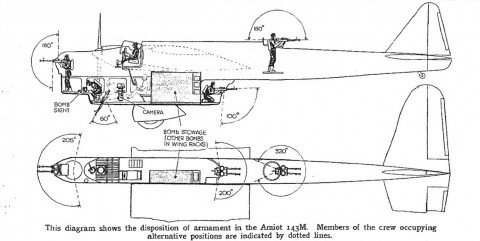
Everybody loves flying aircraft carriers — well, I do, anyway! Above is the closest the British got to the concept. In October 1926, the R33 (above) was used to carry and launch two Gloster Grebe fighters (below). These were relatively heavy aircraft, weighing over a ton each; earlier experiments had used only a single, lighter aeroplane. Although the trials seem to have been successful, I don’t think any of the R100, the R101 or the planned R102 had any capacity for trapeze-launched aeroplanes.
What use might a flying aircraft carrier have been? An article in The Times explained that, should the experiment prove successful:
the first result is that the airship can carry an effective means of defence against other aircraft. Thus its value as a long-distance reconnaissance vessel, able to operate for long periods away from any protection, is increased; while and obvious corollary is that the future airships of 5,000,000 cubic feet capacity, with loads of 20 tons or more, can become aircraft carriers of the air. Six or more machines could probably be slung under the vessel and taken speedily to any threatened point in the Empire; or, alternatively, the interior space of the vessel might be designed to take aircraft with their wings folded for compact stowage.1

The reconnaissance role is the one the only operational flying aircraft carriers of this era, the USS Akron and Macon, were designed to perform.2 It’s hard to see this being useful, or even possible, except at sea. Over land, even a full squadron of onboard fighters could hardly be expected to defend a big, slow-moving, hydrogen-filled airship against any decent air defence (though it would have been a different matter where the Afghan air menace was concerned). The narrow seas such as the Mediterranean and the North Sea would also be problematic, given the proximity of land-based air forces. On the high seas, perhaps in the Indian Ocean or the Pacific, the fighters might ward off ship-launched aircraft — maybe not the full force of an enemy (sailing) aircraft carrier’s air complement, but part of it. Still, I suspect that a hypothetical RAF flying aircraft carrier would have ended up using its aircraft for reconnaissance more than CAP, that is, the same direction that the US Navy’s doctrine was heading in. A few of these would have been very useful for hunting down surface raiders, for example, or U-boats for that matter. So they probably should be thought of as being more like escort carriers than fleet carriers.
The other suggestion here is that such an airship could be used as an aeroplane transporter. I think this would actually have been more attractive to the RAF than any naval co-operation role, actually. Airpower propagandists were wont to argue that one of the advantages of the aeroplane was that it could be rapidly deployed to a danger spot, but this wasn’t really true. Firstly, given the relatively short range of most service aircraft there were no all-red air routes, so flying from Britain to India required flying through the airspace of other countries, and possibly refuelling at their aerodromes. This could of course be politically difficult. Secondly, flying such a long way caused a lot of wear and tear on both machines and men, even if there were no accidents. So most likely they wouldn’t be ready for combat when they arrived, anyway. In practice — certainly when there was no rush — the RAF crated up its aeroplanes and sent them by sea, which I’m sure pleased the Admiralty no end, and the Air Ministry not so much. An airship could deliver a squadron much faster (about 4 days from Cardington to Karachi) and in much better condition.
Finally, I’ve come across another suggested use for flying aircraft carriers: as part of an integrated air defence system. As I discussed recently, in the 1930s defending fighters had less and less time to climb to a suitable height to intercept the incoming bombers after they were detected. But if an aerodrome could be built at 20000 feet, or rather, built on the ground and flown to 20000 feet, the time problem would disappear. Hence J. R. Kennedy’s suggestion of an ‘air base’ — that is, a base floating in air, which could be used for the purposes outlined above, but:
Undoubtedly its most useful role would be to enable a standing defence patrol to be maintained in the air. Thus [air]ships would be stationed round cities at great heights, carrying interceptor planes which they would loose against an enemy, themselves beating a rapid retreat on his appearance.3
Now that’s thinking different!4 It probably wouldn’t have been wise to rely too much on airships for air defence, as they would have been terribly vulnerable to long-range enemy fighters. But they could have been deployed in order to blunt the initial few attacks, which would have been the most damaging under the knock-out blow paradigm. Still, I don’t think the RAF has cause to regret choosing radar and ground-based interceptors for the air defence of the realm over flying aircraft carriers, no matter the proportion of awesome in the constitution of the latter.
Image source: “R.33 as aircraft carrier”, Flight, 28 October 1926, 703, 705.
![]() This work is licensed under a Creative Commons Attribution-NonCommercial-NoDerivatives 4.0 International License.
Permissions beyond the scope of this license may be available at http://airminded.org/copyright/.
This work is licensed under a Creative Commons Attribution-NonCommercial-NoDerivatives 4.0 International License.
Permissions beyond the scope of this license may be available at http://airminded.org/copyright/.
- The Times, 20 October 1926, p. 13. [↩]
- Though I should mention the Soviet Zveno bombers, some of which were used in the early months of Barbarossa. [↩]
- J. R. Kennedy, Modern War and Defence Reconstruction (London: Hutchinson & Co., 1936), 209. [↩]
- It occurs to me that slip-wings could have been used for this purpose too. Noel Pemberton-Billing, their most ardent proponent, did not suggest this as far as I know; but then he was writing after the Battle of Britain and during the Blitz, when the problem was not height but light. [↩]






Somewhere between escort carriers and MAC ships?
Higher speed than ships (could move between convoys?), but less endurance and impacted by bad weather for longer.
ObWW1: AP1 was, I think, modified Sea Scout envelope with a BE2 attached beneath it. The idea was to use the blimp’s endurance to hang about at 10,000 ft waiting for Zeppelins, then when one arrived, let the envelope go, and chase after it. It all turned out rather badly: the release mechanism fouled on the test flight, upending the plane and killing both pilots, one of whom was the designer.
Just come accross this: Ideas to put the Zeppelin threat at bay…
http://home.att.net/~dannysoar3/zepcomics.htm
ErrolC:
Yes, that sounds about right. Airships could cross the Atlantic non-stop, and blimps were useful in the anti-sub role in both world wars (though only coastally, AFAIK). Though now that you mention bad weather … given the number of airships lost to storms, the North Atlantic wouldn’t be the best place to have them patrol. The money would probably be better invested in a few more Sunderlands or VLR Liberators anyway.
Chris:
You’re right! AP-1 (‘airship plane 1’), an SS with a BE.2c underneath. Trials in 1915 were successful but the operational test on 21 February 1916 was a disaster as you say. AP-2 was already completed but scrapped. Ces Mowthorpe, Battlebags: British Airships of the First World War (Stroud: Sutton, 1995), 43. Kennedy did say that ‘air bases’ had been used in WWI, though he says they were used successfully for coastal patrols (against what, I don’t know). I just assumed he was thinking of the SSs which used aeroplane fuselages as makeshift gondolas.
Ricardo:
Well, anything is worth trying once! Some great pics on that site, thanks.
The Bell Geddes Airliner #4 (Brett’s “that site” link above). Wow!
Pingback: Airminded · The dream of unmanned flight
Pingback: Airminded · Future schemes of air defence